fuel CHEVROLET CAVALIER 1996 3.G Owners Manual
[x] Cancel search | Manufacturer: CHEVROLET, Model Year: 1996, Model line: CAVALIER, Model: CHEVROLET CAVALIER 1996 3.GPages: 372, PDF Size: 19.73 MB
Page 7 of 372
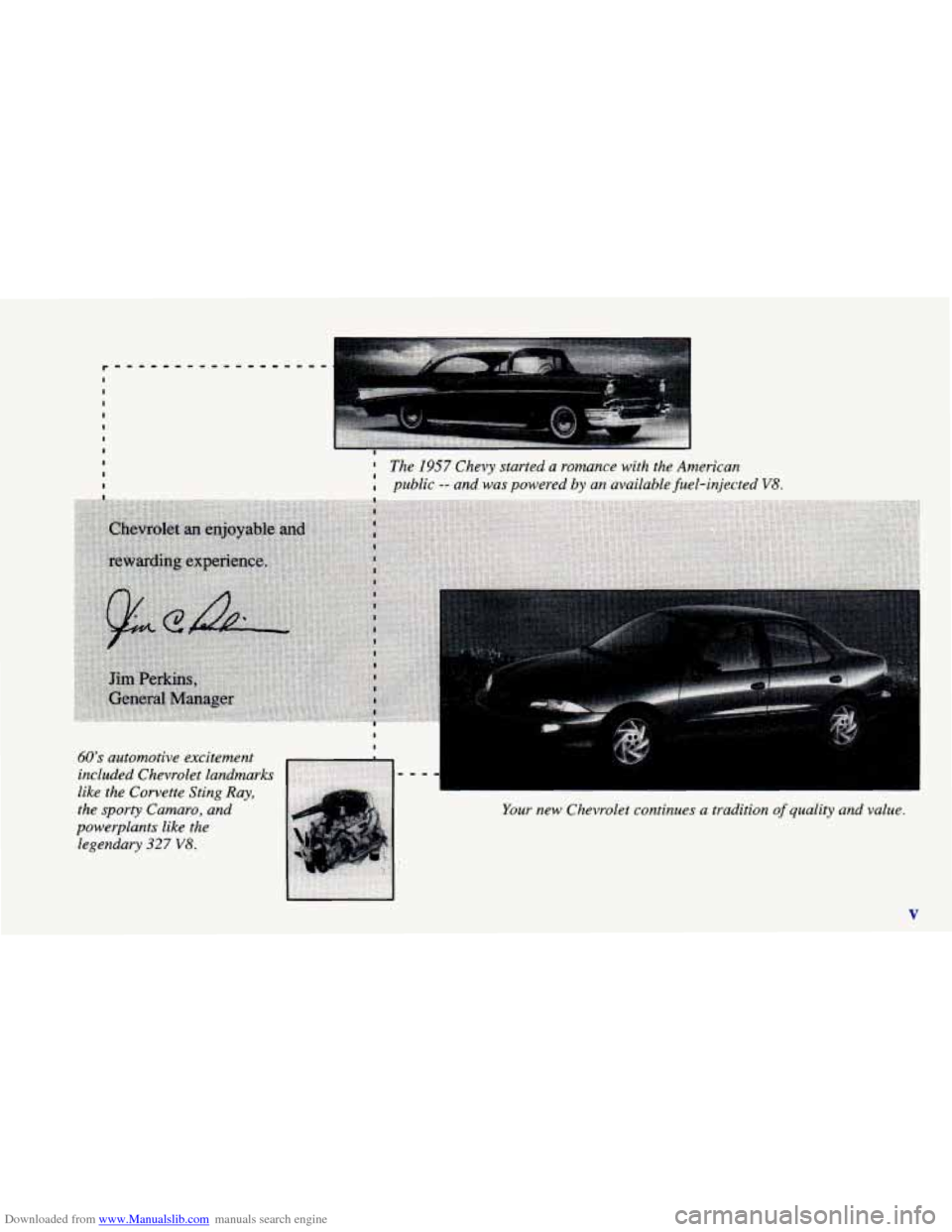
Downloaded from www.Manualslib.com manuals search engine I The 1957 Chevy started a romance with the American
public
-- and was powered by an available fuel-injected V8.
legendary 327 V8.
Your new Chevrolet continues a tradition of quality and value.
V
Page 10 of 372
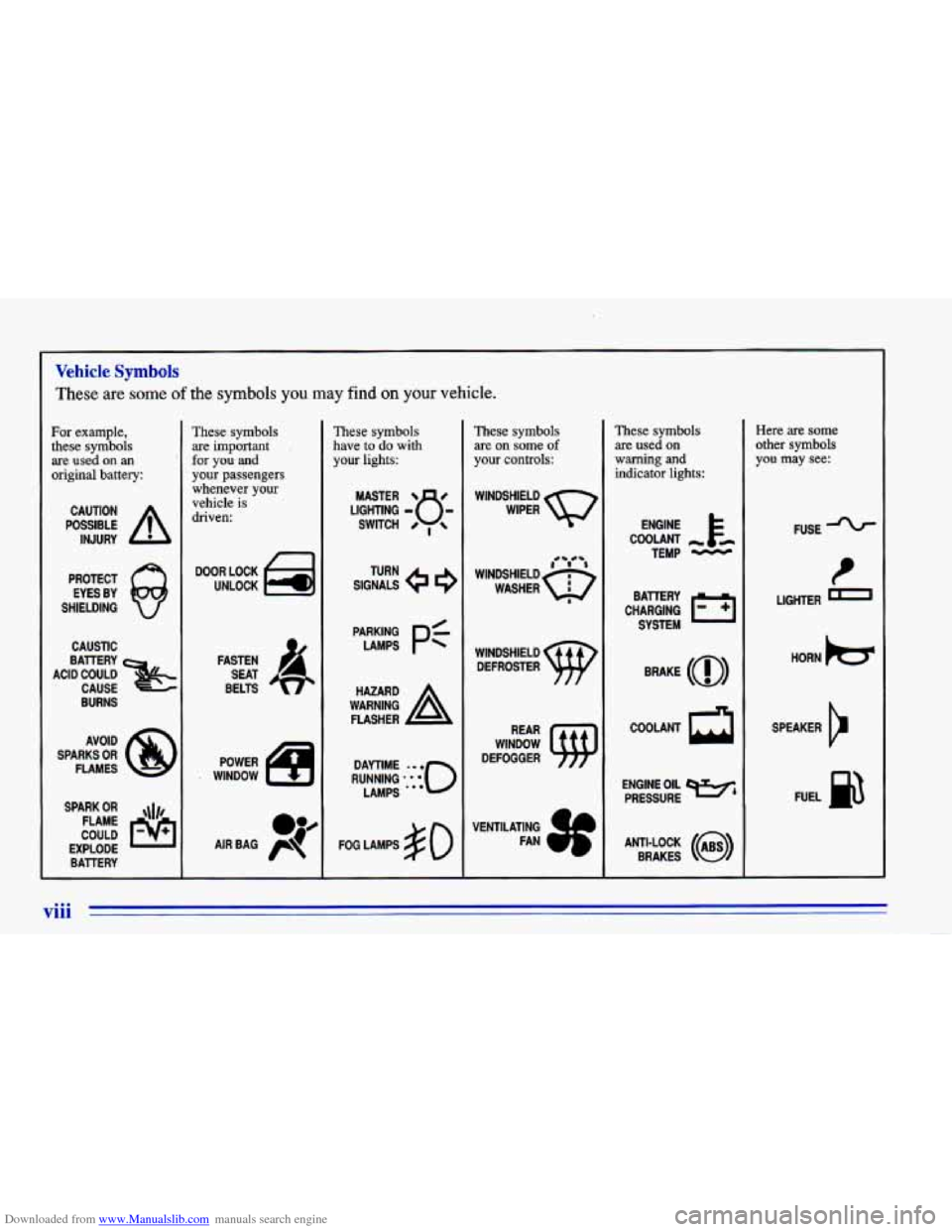
Downloaded from www.Manualslib.com manuals search engine Vehicle Symbols
These are some of the symbols you may find on your vehicle.
For example,
these symbols
are used
on an
original battery:
POSSIBLE A
CAUTION
INJURY
PROTECT EYES BY
SHIELDING
CAUSTIC
BURNS
SPARK
OR ,\I/,
COULD FLAME
EXPLODE BATTERY
These symbols
are important
for you
and
your passengers whenever your
vehicle
is
driven:
FASTEN
SEAT
BELTS
These symbols
have
to do with
your lights:
SIGNALS @
TURN
FOG LAMPS
$0
These symbols are on some
of
your controls:
WINDSHIELD
DEFROSTER
These symbols are used on
warning
and
indicator lights:
COOLANT -
TEMP -
CHARGING I-1
BAllERY
SYSTEM
BRAKE
(a)
COOLANT a
ENGINE OIL e,
PRESSURE
ANTI-LOCK
(@)
BRAKES
Here are some
other symbols
you may see:
FUSE
LIGHTER
m
HORN )a(
SPEAKER
b
FUEL B
viii
Page 67 of 372
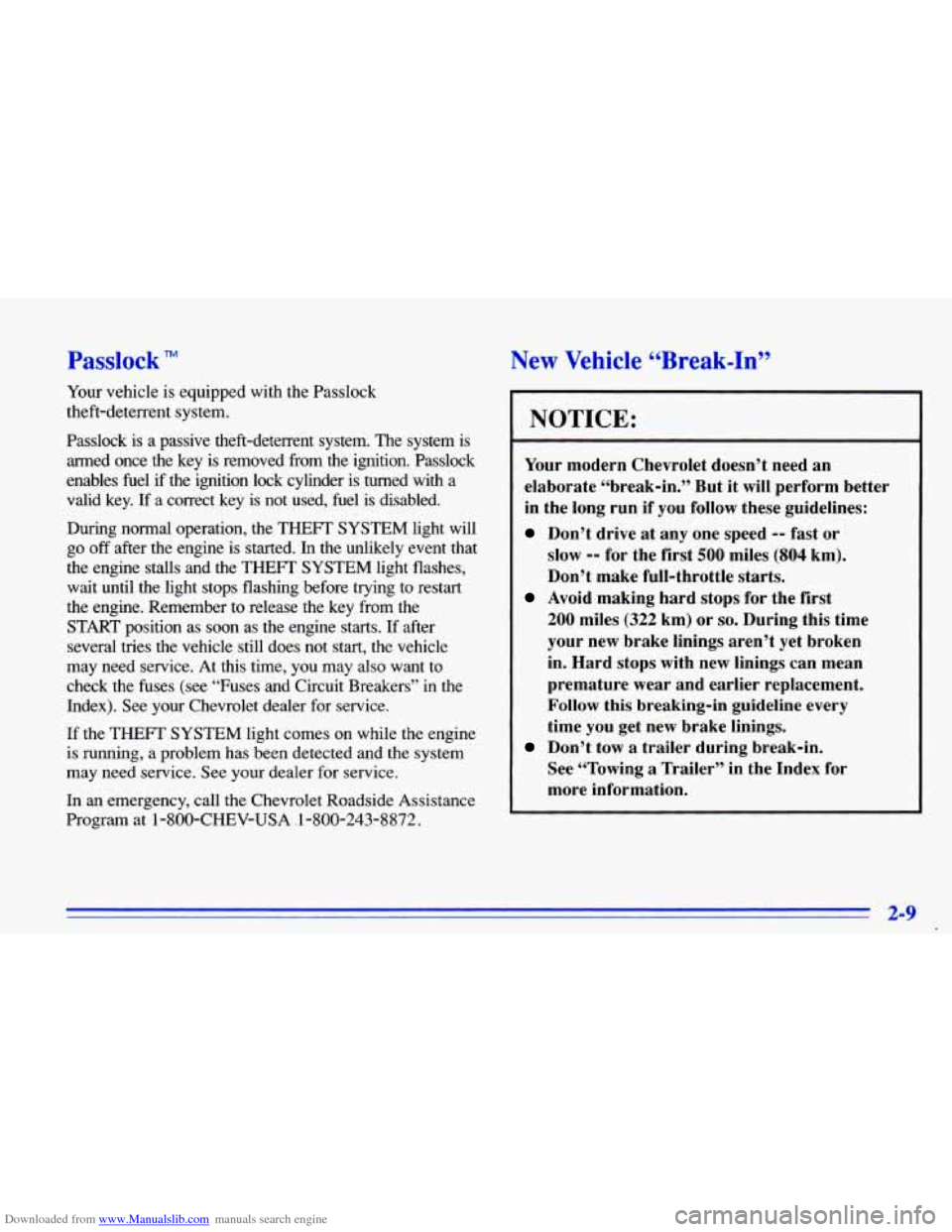
Downloaded from www.Manualslib.com manuals search engine Passlock TM
Your vehicle is equipped with the Passlock
theft-deterrent system.
Passlock is a passive theft-deterrent system. The system is armed once the key is removed from the ignition. Passlock
enables fuel if the ignition lock cylinder is turned with a
valid key.
If a correct key is not used, fuel is disabled.
During normal operation, the THEFT SYSTEM light will
go off after the engine
is started. In the unlikely event that
the engine stalls and the THEFT SYSTEM light flashes,
wait until the light stops flashing before trying to restart
the engine. Remember to release the key from the START position as soon as the engine starts. If after several tries the vehicle still does not start, the vehicle
may need service. At this time, you may also want to
check the fuses (see “Fuses and Circuit Breakers” in the\
Index). See your Chevrolet dealer for service.
If the THEFT SYSTEM light comes on while the engine
is running, a problem has been detected and the system
may need service.
See your dealer for service.
In
an emergency, call the Chevrolet Roadside Assistance
Program at
1-800-CHEV-USA I 1-800-243-8872.
New Vehicle LLBreak-InT’
NOTICE:
Your modern Chevrolet doesn’t need an
elaborate “break-in.” But it will perform better
in the long run if you follow these guidelines:
Don’t drive at any one speed -- fast or
slow -- for the first 500 miles (804 km).
Don’t make full-throttle
starts.
200 miles (322 km) or so. During this time
your new brake linings aren’t yet broken
in. Hard stops with new linings can mean
premature wear and earlier replacement.
Follow this breaking-in guideline every
time you get new brake linings.
See “Towing
a Trailer” in the Index for
more information.
Avoid making hard stops for the first
Don’t tow a trailer during break-in.
2-9
Page 73 of 372
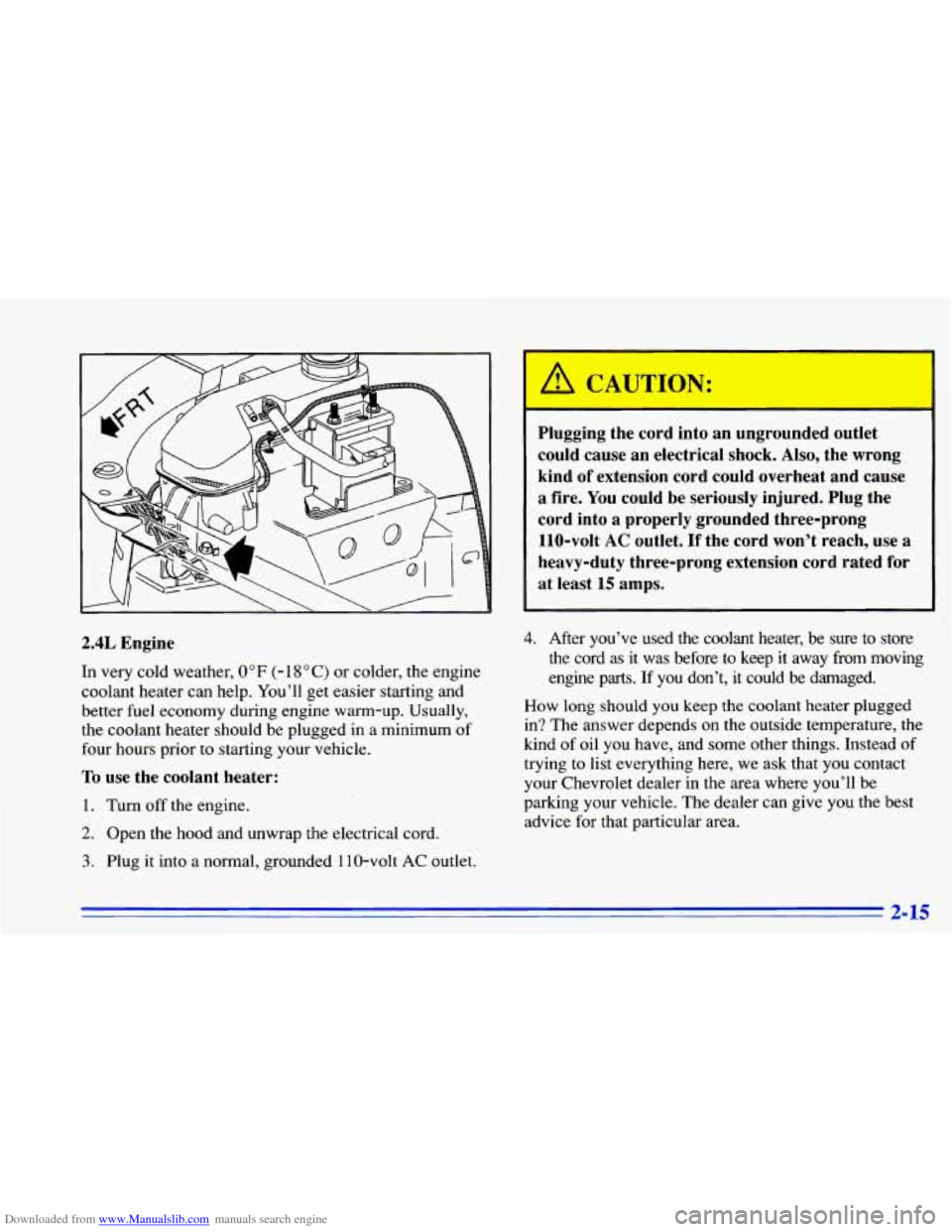
Downloaded from www.Manualslib.com manuals search engine Plugging the cord into an ungrounded outlet
could cause an electrical shock. Also, the wrong
kind
of extension cord could overheat and cause
a fire. You could be seriously injured. Plug the
cord into
a properly grounded three-prong
110-volt AC outlet.
If the cord won’t reach, use a
heavy-duty three-prong extension cord rated for
at least 15 amps.
2.4L Engine
In very cold weather,
0°F (- 18 O C) or colder, the engine
coolant heater can help. You’ll get easier starting and
better fuel economy during engine warm-up.
Usually,
the coolant heater should be plugged in a minimum of
four hours prior to starting your vehicle.
To use the coolant heater:
1. Turn off the engine.
2. Open the hood and unwrap the electrical cord.
3. Plug it into a normal, grounded 110-volt AC outlet.
4. After you’ve used the coolant heater, be sure to store
the cord as it was before to keep it away from moving
engine parts. If you don’t, it could be damaged.
How long should
you keep the coolant heater plugged
in? The answer depends on the outside temperature, the
kind of oil you have, and some other things. Instead
of
trying to list everything here, we ask that you contact
your Chevrolet dealer in the area where you’ll be
parking your vehicle. The dealer can give you the best
advice for that particular area.
2-15
Page 76 of 372
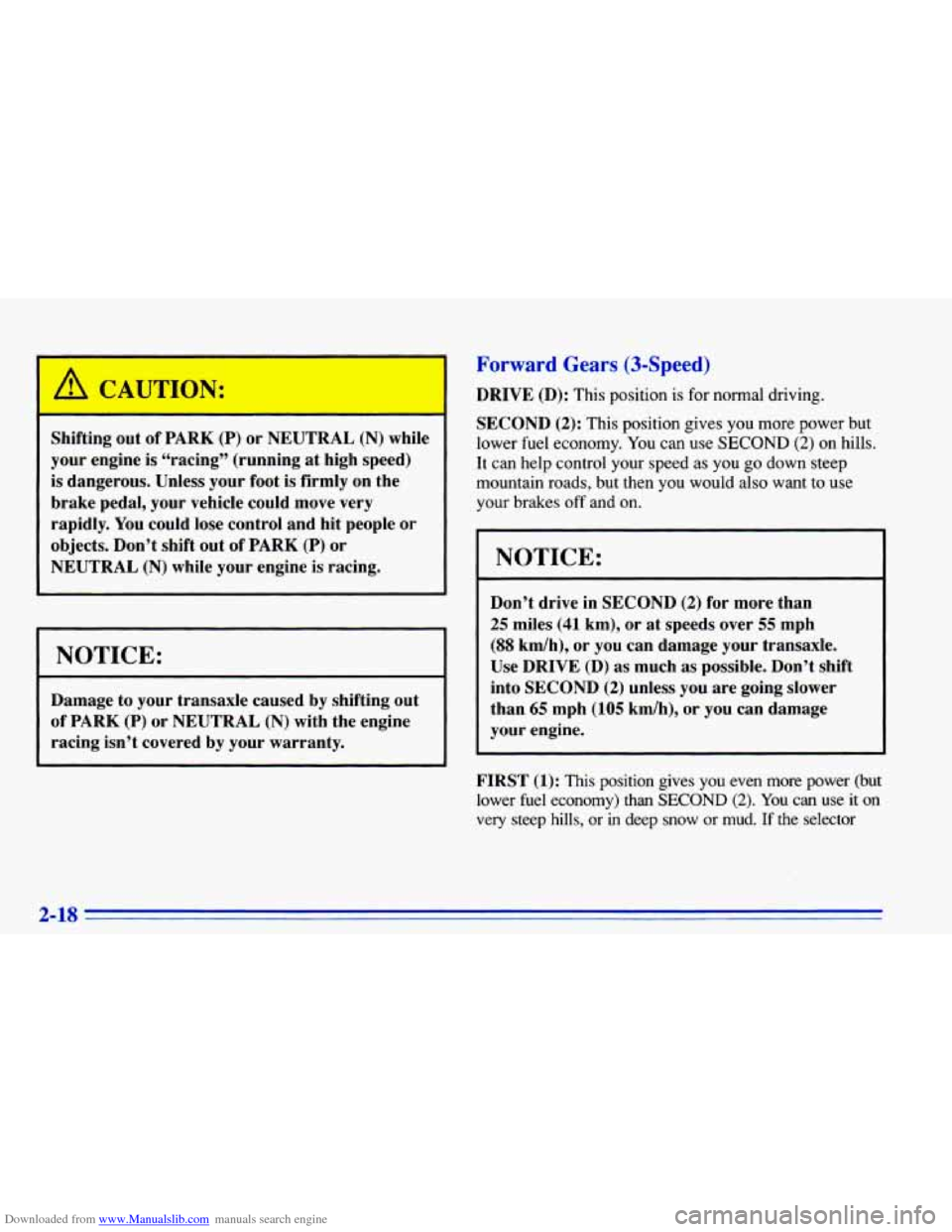
Downloaded from www.Manualslib.com manuals search engine A CAUTION:
Shifting out of PARK (P) or NEUTRAL (N) while
your engine is “racing” (running at high speed)
is dangerous. Unless your foot is firmly
on the
brake pedal, your vehicle could move very
rapidly. You could lose control and hit people or
objects. Don’t shift out
of PARK (P) or
NEUTRAL
(N) while your engine is racing.
I NOTICE:
Damage to your transaxle caused by shifting out
of PARK (P) or NEUTRAL (N) with the engine
racing isn’t covered by your warranty.
Forward Gears (3-Speed)
DRIVE (D): This position is for normal driving.
SECOND
(2): This position gives you more power but
lower
fuel economy. You can use SECOND (2) on hills.
It can help control your speed
as you go down steep
mountain roads, but then you would also want to
use
your brakes off and on.
I NOTICE:
Don’t drive in SECOND (2) for more than
25 miles (41 km), or at speeds over 55 mph
(88 km/h), or you can damage your transaxle.
Use DRIVE (D)
as much as possible. Don’t shift
into SECOND
(2) unless you are going slower
than
65 mph (105 km/h), or you can damage
your engine.
FIRST
(1): This position gives you even more power (but
lower fuel economy)
than SECOND (2). You can use it on
very steep hills, or
in deep snow or mud. If the selector
2-18
Page 77 of 372
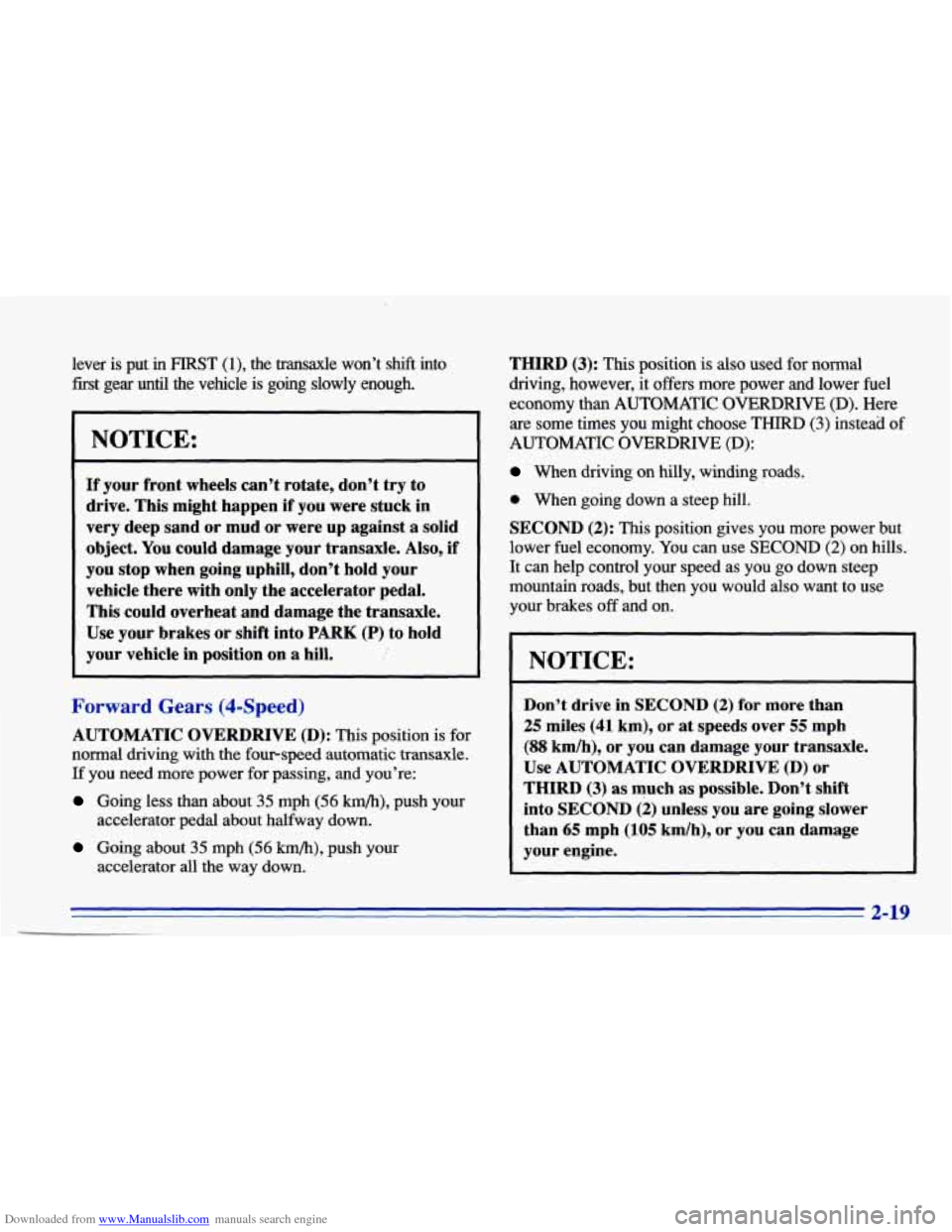
Downloaded from www.Manualslib.com manuals search engine lever is put in FIRST (l), the transaxle won’t shift into
first gear until the vehicle is going slowly enough.
NOTICE:
If your front wheels can’t rotate, don’t try to
drive. This might happen if you were stuck in
very deep sand or mud or were up against a solid
object.
You could damage your transaxle. Also, if
you stop when going uphill, don’t hold your
vehicle there with only the accelerator pedal.
This could overheat and damage the transaxle.
Use your brakes or shift into PARK (P) to hold
your vehicle in position
on a hill.
Forward Gears (4-Speed)
AUTOMATIC OVERDRIVE (D): This position is for
normal driving with the fourspeed automatic transaxle.
If you need more power for passing, and you’re:
Going less than about 35 mph (56 km/h), push your
accelerator pedal about halfway down.
Going about 35 mph (56 km/h), push your
accelerator
all the way down. THIRD
(3): This position is also used for normal
driving, however, it offers more power and lower fuel
economy than AUTOMATIC OVERDRIVE
(D). Here
are some times you might choose
THIRD (3) instead of
AUTOMATIC OVERDRIVE (D):
When driving on hilly, winding roads.
0 When going down a steep hill.
SECOND
(2): This position gives you more power but
lower fuel economy.
You can use SECOND (2) on hills.
It can help control your speed as you go down steep
mountain roads, but then you would
also want to use
your brakes
off and on.
NOTICE:
Don’t drive in SECOND (2) for more than
25 miles (41 km), or at speeds over 55 mph
(88 km/h), or you can damage your transaxle.
Use AUTOMATIC OVERDRIVE (D) or
THIRD
(3) as much as possible. Don’t shift
into
SECOND (2) unless you are going slower
than
65 mph (105 km/h), or you can damage
your engine.
2-19
Page 78 of 372
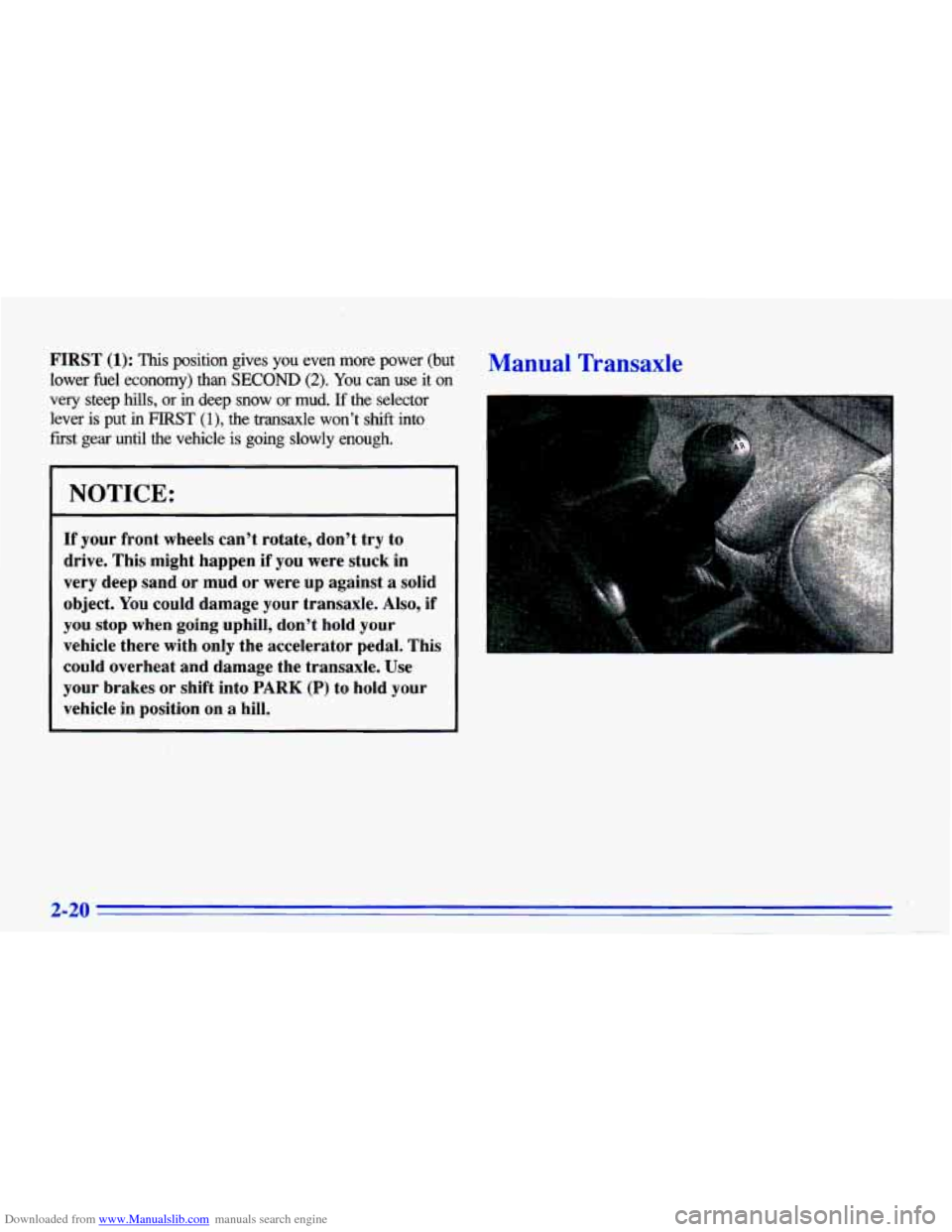
Downloaded from www.Manualslib.com manuals search engine FIRST (1): This position gives you even more power (but
lower fuel economy) than
SECOND (2). You can use it on
very
steep hills, or in deep snow or mud. If the selector
lever
is put in FIRST (1)’ the transaxle won’t shift into
first gear until the vehicle is going slowly enough.
NOTICE:
If your front wheels can’t rotate, don’t try to
drive. This might happen
if you were stuck in
very deep sand or mud or were
up against a solid
object.
You could damage your transaxle. Also, if
you stop when going uphill, don’t hold your
vehicle there with only the accelerator pedal. This
could overheat and damage the transaxle. Use
your brakes or shift into PARK (P) to hold your
vehicle in position on
a hill.
Manual Transaxle
2-20
. --
Page 80 of 372
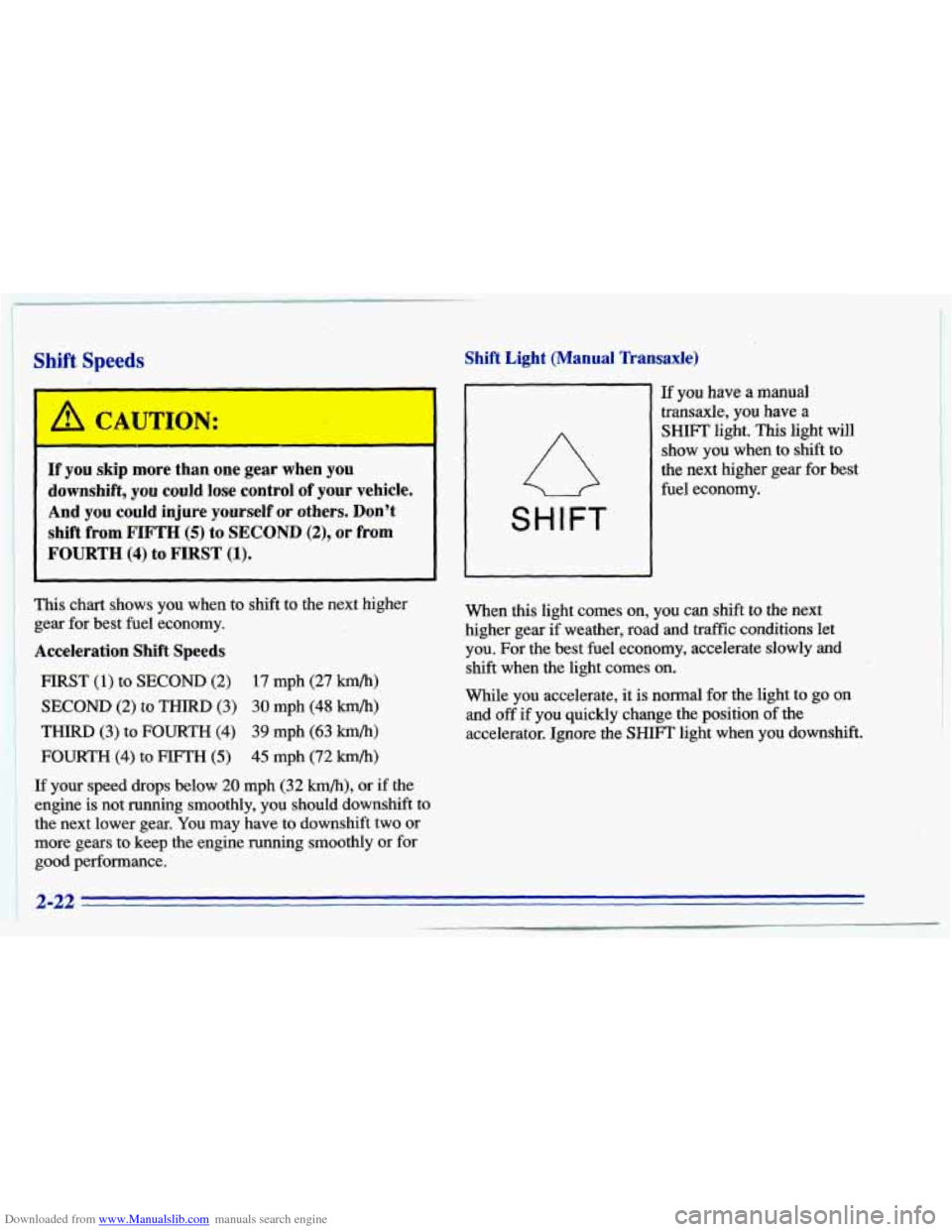
Downloaded from www.Manualslib.com manuals search engine I
j Shift Speeds
/r CAUTION:
r
If you skip more than one gear when you
downshift, you could lose control of your vehicle.
And
you could injure yourself or others. Don’t
shift from FIFTH (5) to SECOND (2), or from
FOURTH (4) to FIRST (1).
This chart shows you when to shift to the next higher
gear for best
fuel economy.
~ Acceleration Shift Speeds
FIRST (1) to SECOND (2) 17 mph (27 ludh)
SECOND (2) to THIRD (3) 30 mph (48 km/h)
THIRD (3) to FOURTH (4) 39 mph (63 kmh)
FOURTH (4) to FWTH (5) 45 mph (72 km/h)
: If your speed drops below 20 mph (32 km/h), or if the
~ engine is not running smoothly, you should downshift to
the next lower gear. You may have to downshift two or
1 more gears to keep the engine running smoothly or for
good performance. I
Shift Light (Manual Transaxle)
SHIFT
If you have a manual
transaxle, you have a
SHIFT light. This light will
show you when to
shift to
the next higher gear
for best
fuel economy.
When this light comes
on, you can shift to the next
higher gear. if weather, road and traffic conditions
let
you. For the best fuel economy, accelerate slowly and
shift when the light comes on.
While you accelerate,
it is normal for the light to go on
and
off if you quickly change the position of the
accelerator. Ignore the
SHIFT light when you downshift.
2-22
Page 119 of 372
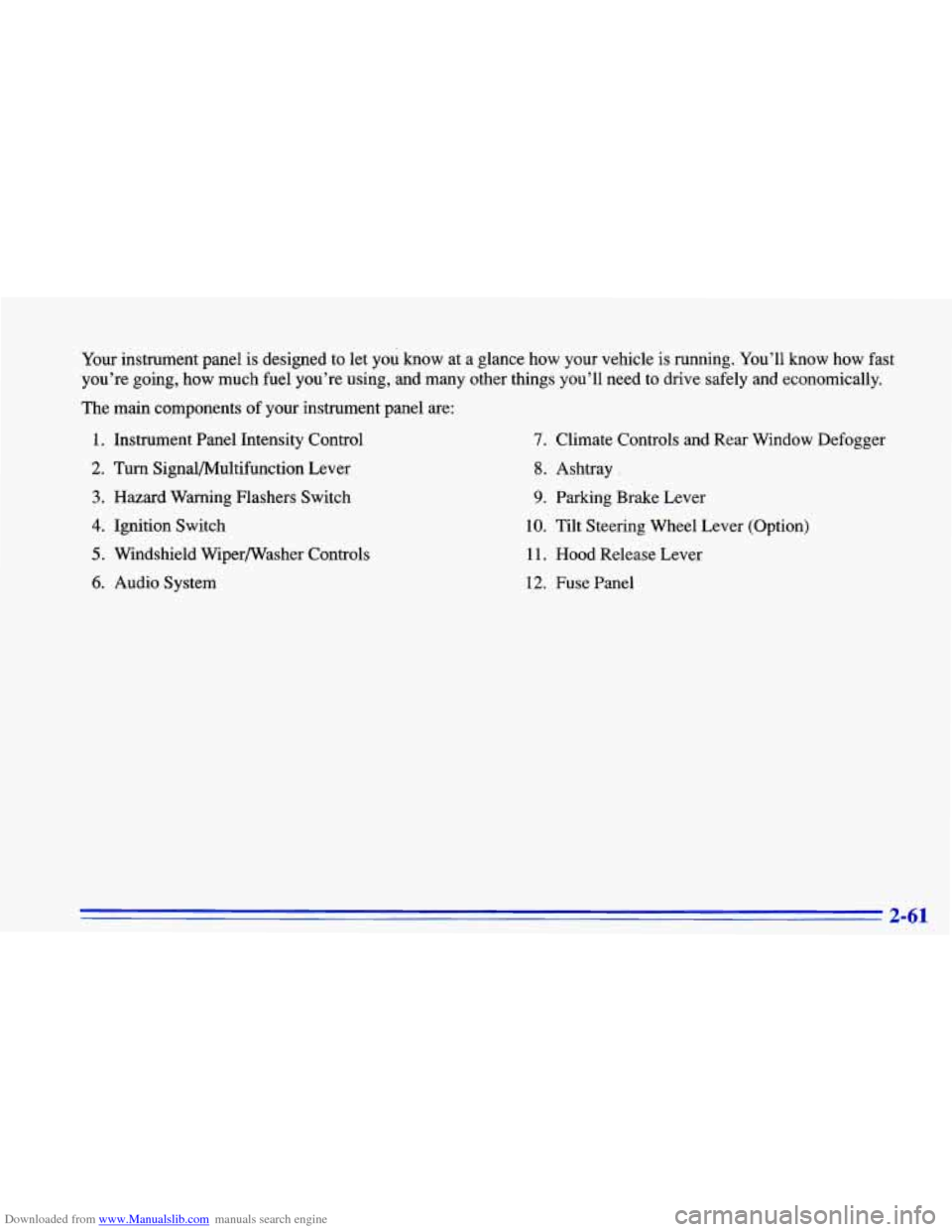
Downloaded from www.Manualslib.com manuals search engine Your instrument panel is designed to let you know at a glance how your vehicle is running. You’ll know how fast
you’re going, how much fuel you’re using, and many other things you’ll need to drive safely and economically.
The main components of your instrument panel are:
1. Instrument Panel Intensity Control
2. Turn Signal/Multifunction Lever
3. Hazard Warning Flashers Switch
4. Ignition Switch
5. Windshield Wiperwasher Controls
6. Audio System
7. Climate Controls and Rear Window Defogger
8. Ashtray .
9. Parking Brake Lever
10. Tilt Steering Wheel Lever (Option)
11. Hood Release Lever
12. Fuse Panel
2-61
Page 120 of 372
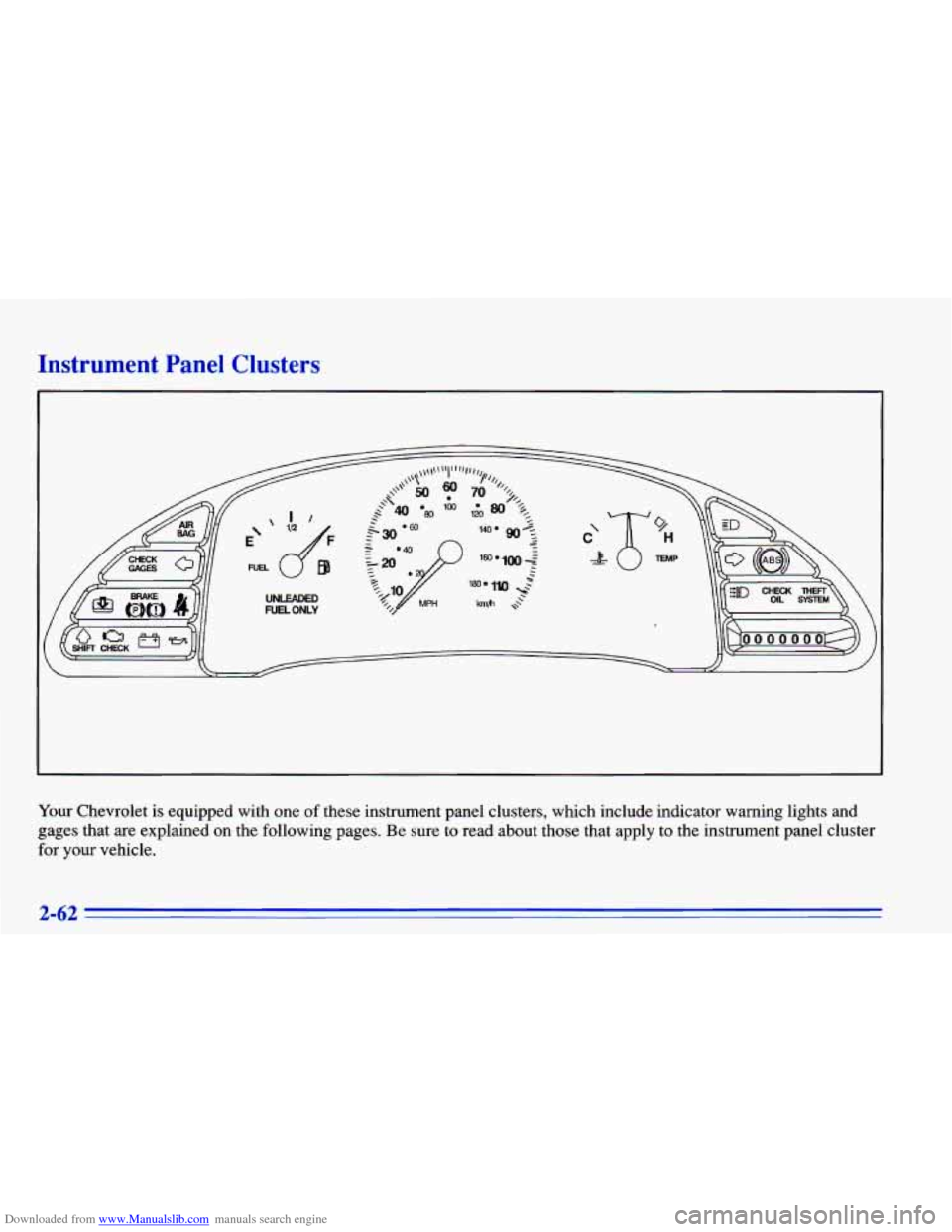
Downloaded from www.Manualslib.com manuals search engine Instrument Panel Clusters
UNLEADED FUEL ONLY
Your Chevrolet is equipped with one of these instrument panel clusters, which include indicator warning lights and
gages that
are explained on the following pages. Be sure to read about those that apply to the instrument panel cluster
for
your vehicle.
2-62